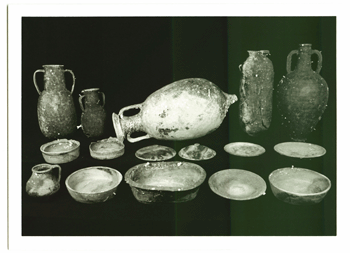
|
|
|
|
An empty space now separates the stone from the cargo of pottery 8 m to the SE: basins, saucepans, casseroles, frying pans, bowls, lid-plates, jars jugs and pitchers. Many of the vessels are still stacked as they were shipped, nestled one into another according to size. From Skerki F, 26 artifacts were recovered, including seven amphoras. The petrological analyses of their fabrics by D. F. Williams indicates that they come from North Africa, Spain, Sicily and Pompeii. Of particular interest are three amphoras of the same form but in graduated sizes, suggesting that their contents were for a diverse and varied market.14 This flat-bottomed shape is known to me only from an example in Pompeii and one in Padua. A dipinto on the vessel from Pompei identifies the contents as lomentum. Pliny the Elder 15 describes lomentum as both a blue pigment and a powder made from bean meal used as a cosmetic, detergent and medicine. Also represented on Skerki Wreck F is a flat-bottomed wine jar from Sicily, a very popular shape from the first through the fourth centuries A.D. 16 Originating in Naxos, Sicily, the form is also found at Pompeii and Ostia, dated by Clementina Panella between 30 and 100 A.D. 17 Another wine amphora comes from Tarraconensis in Spain. This general class of amphoras , frequently referred to as Dresel 2-4, includes many variants of form and fabric and is based on the famous Greek Koan wine amphoras with double rolled handles made on the island of Kos.18 The Italian pseudo-Koan amhoras are among the most common wine amphoras in use during the period from the latter part of the first century B.C. and the first century A.D. The adaptation of this very popular Greek wine jar by the Romans illustrates their clever business skills for the marketing of their own product. They were produced in great numbers in both the eastern and western Mediterranean. Another amphora from Skerki Wreck F was probably carrying garum sauce from Baetica, Spain.19 This jar belongs to a widespread class of amphoras, Dressel Forms 7-11, commonly associated with garum or other fish products. This general type of vessel is commonly found on many Roman sites, especially military ones. The main floruit of the type is from the late first century B.C. to the first century A.D. The Skerki example appears closest to forms dating around the mid-first century and may be grouped with Dressel 9 amphoras.20 Either garum or oil were probably the contents of a small neo-Punic amphora of Tunisian origin.21 Some of the kitchenware also has been identified by John P. Oleson, now studying this material, as from the North African coast.22 Where was Skerki F loaded and where was its destination? Because of the weight of the stone cargo, it is likely that it was loaded first at Alexandria. The ship may then have picked up the large shipment of kitchenware and amphoras in Carthage or another costal city along the North African coast, to head on to Sicily and southern Italy. Of course, amphoras from Spain, Sicily and Pompeii could have been loaded at any of the large trans-shipment centers as Carthage, Tarraconensis or Puteoli. |
|
|
12. McCann 2001. 13. See McCann 2001, fig. 3, a cargo vessel under full sail on a Roman sarcophagus in the National Museum in Beirut, dating in the second half of the first century A.D. 14. SK97.097,.103,.104. 15. Plin.nat. 18,117; 33,89; 33,162. I am particularly grateful to Elizabeth Lyding Will for these references as well as for other help with amphora studies. I also would like to thank Joann Freed, Archer Martin and Clementina Panella for their many helpful suggestions. 17. See C. Panella, Anfore. In: A. Carandini and C.Panella (eds.), Ostia III. Le terme del Nuotatore. Scavo degli ambienti III, VI, VII. Scavo dell'ambiente V e di un saggio nel'area SO. Stud. Miscellanei 21 (Roma 1973) 632 no. 43. 18. SK97.081. For full discussion of this type with bibliography see McCann 2001, pp. 259-262, fig. 9. 19. SK97.082. See D. P. S. Peacock and D. F. Williams, Amphorae and the Roman Economy, an Introductory Guide ( London, New York 1986), Class 16A, 117-119. For discussion of type see McCann 2001, p. 262, and fig. 10. 20. See M. Sciallano and P. Sibella, Amphores: Comment les identifier? (Aix-en-Provence 1991). |

